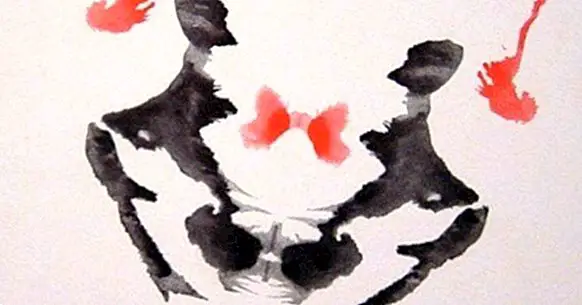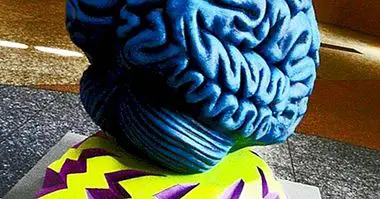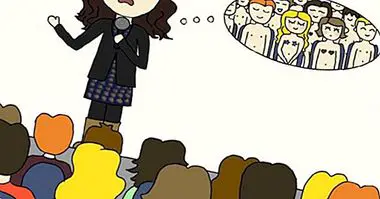The Rorschach inkblot test
Ink stains forming mysterious symmetrical figures . These are the figures (or, rather, the non-figures) that are used in one of the most known projective tests: the Rorschach test .
It is a method born in the first half of the twentieth century, when psychoanalysis dominated Europe, and whose use has become popular both in personnel selection processes and even in the clinical field. But ... on what ideas is the Rorschach test based? How is it used? Is it effective and reliable?
To answer these questions we have to start by knowing the person who invented the inkblot test: the Swiss psychoanalyst Hermann Rorschach.

Who was Hermann Rorschach?
Hermann Rorschach was born in Zurich in 1884, and from a young age he showed a great fondness for creating figures through the use of paint. After graduating in medicine he began to specialize in psychiatry, and these studies made him fully enter the world of psychoanalysis, which at that time was the psychological current that was becoming more popular in Europe.
In this way, Rorschach became very familiar with the concepts of free association and of projection , which at that time were used by Sigmund Freud and his followers in clinical practice. Rorschach was the first to use the term "psychodiagnosis" to refer to the interpretation of symptoms to discover the mental alterations that disturb the well-being of people.
But what Rorschach understood as psychodiagnostics was far from resembling a medical evaluation based on the observation of objective properties. For him, the diagnosis had to start from the interpretation of the way in which the unconscious of the patients is manifested through the creations of these. Specifically, Rorschach focused on the interpretation of artistic works created by patients to try to understand the functioning of your mind. This idea was the seed that later gave way to the creation of the Rorschach test based on ink spots.
The Rorschach test
In the year 1921, Rorschach published a book called Psychodiagnosis. This monograph presented for the first time a psychological test based on the interpretation of ten cards in which symmetrical ink spots were shown. The curious thing about these pictures was that the property that defined the figures that appeared in them was their total ambiguity .
The spots had no apparent meaning, and of course Rorschach had taken great care to avoid that his creations could be interpreted in a clear way.
The test of the stains that had created put the accent on total freedom when it comes to attributing meaning to those figures . It was a tool designed to be used in the diagnosis of psychological characteristics, but at the same time it shied away from the possibility of measuring specific and well-defined answers that would allow comparing the results obtained by different people.
Rorschach wanted that each one could give the answer that seemed to him, and the fan of possibilities of answer was infinite, unlike what happens in the tests of personality in which it is necessary to select a response among several available. To understand why this peculiarity must understand the value that is given to the interpretation from psychoanalysis.

Interpreting spots
The idea in which Rorschach relied to propose to create a system of psychological evaluation was totally related to the Freudian concept of the unconscious.
The unconscious was, for Freud, a slope of the mind whose form has been given by old traumas and irrepressible desires . Hypothetically, this psychic instance that directs our way of thinking and acting, even if we do not realize it, but must always remain hidden from our consciousness. That is why the unconscious is constantly being repressed by psychic structures that fight so that it does not assault the conscience, and this continuous struggle can generate psychopathologies.
However, Rorschach also knew the other side of the coin about the repression of the unconscious according to Freud. The creator of psychoanalysis believed that contents of the unconscious can emerge to consciousness and manifest indirectly through symbolic disguises that, by hiding the true nature of what is to be repressed, do not jeopardize the stability of consciousness. For example, proposed the idea that dreams are symbolic manifestations of desires that must be repressed .
But this way of symbolically disguising elements of the unconscious does not occur only in dreams, but in many other dimensions of human activity.Rorschach came to the conclusion that a part of the unconscious can be projected in symbolic interpretations of what is seen, and that is why he tried to create a psychological test in which people had to interpret totally ambiguous figures, without any apparent meaning . In this way, the way in which they interpreted these totally meaningless forms would reveal hidden aspects of their mind.
The Rorchach test today

Rorschach died at the age of just 37, months after publishing the book that would make him famous, and his test of symmetrical inkblots soon began to gain popularity. It began to be used as a diagnostic tool for mental disorders, but its fundamental use was the personality test .
It reached a point where it became popular in the field of personnel selection, which was one of the most used tools in the world of Human Resources, and also entered into forensic psychology to become a resource of expertise in legal proceedings .
Even today, the Rorschach inkblot test is widely used both in the judicial field and in companies, and the different psychodynamic schools have continued working to try to improve the interpretation criteria that the Swiss psychoanalyst began. . In fact, much effort has been put into perfecting a system for interpreting the results of the Rorschach test, the best known being the Rorschach Comprehensive System driven in the 60s by John E. Exner .
However, the popularity of the Rorschach spots test runs in parallel to another fact that must be taken into account: the Rorschach test does not have the validity or reliability that one would expect from a resource with good empirical bases . That is why the use of these spots to evaluate psychological characteristics is considered a pseudoscientific practice.
Criticism of the Rorschach test
The first argument that is used to link the wide test with pseudoscience refers to the epistemological paradigm on which psychoanalysis rests and the Freudian theories that have given rise to the psychodynamic current of psychology. This is because Rorschach's ideas about the unconscious can not be tested or falsified : there is no clear way to rule out the possibility that a person has a childhood trauma or wants to be protected by an authority figure, for example, because explanations about the unconscious forces that move the person can always be modified on the fly without compromising the initial hypotheses.
Similarly, if someone sees a unicorn in one of the Rorschach plates, there are countless ways to justify that person is very introverted, for example. This criticism, therefore, calls into question the validity of the theories on which the Rorschach test is based.
The second aspect of the criticisms directed against the Rorschach test is of a more pragmatic nature and calls into question the usefulness of the test as a diagnostic or personality test tool. He points out that it is not a valid or reliable instrument and that through its use, many robust correlations have not been found that allow us to establish what kind of responses reflect what kind of psychological tendencies . The way in which the responses of the people who undergo the test are interpreted fail to reflect clear trends, and in general the conclusions reached are arbitrary or based on biases.
Conclusions
The Rorschach test is one of the most iconic and well-known inventions. He has appeared in series, novels, movies and even gives name to one of the most famous comic characters of writer and screenwriter Alan Moore . It is also usually understood as one of the resources that psychologists use to study personality. However, the fact that its theoretical foundations are so questioned greatly undermines its credibility as a diagnostic tool or psychotechnical test.
Bibliographic references:
- Gacono, C. B. and Evans, B. (2007). The Handbook of Forensic Rorschach Assessment (Personality and Clinical Psychology). New York: Lawrence Erlbaum and Associates.
- Lilienfeld, S.O., Wood, J.M., Garb, H.N. (2000). The scientific status of projective techniques. Psychological Science in the Public Interest, 1 (2), pp. 27-66.
- Sutherland, S. (2013). Irrationality: the enemy within. London: Pinter & Martin.
- Wood, J.M., Nezworski, M.T., Lilienfeld, S.O., Garb, H. N. (2003). What's Wrong with the Rorschach ?. San Francisco: Jossey-Bass.



















